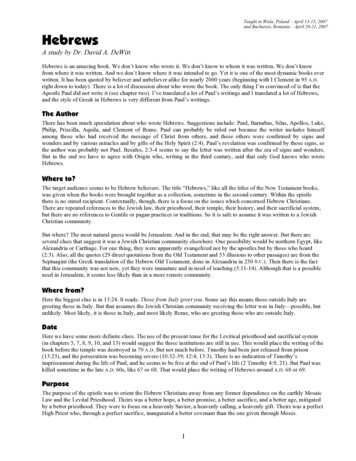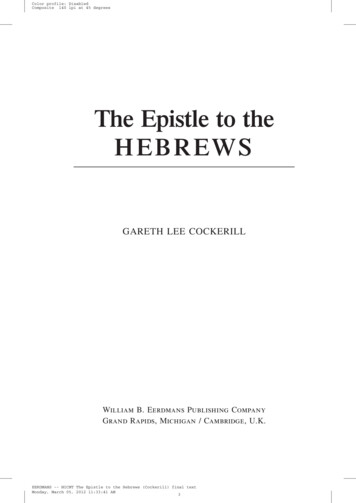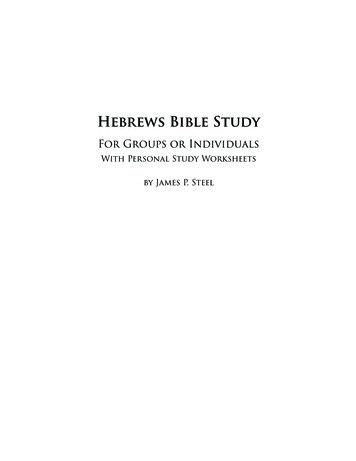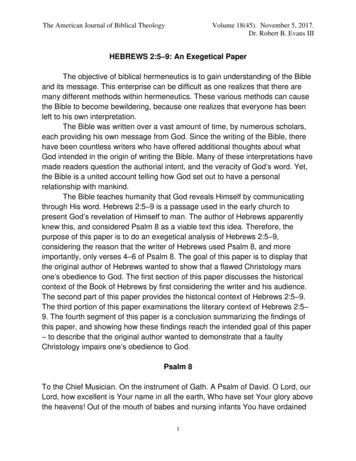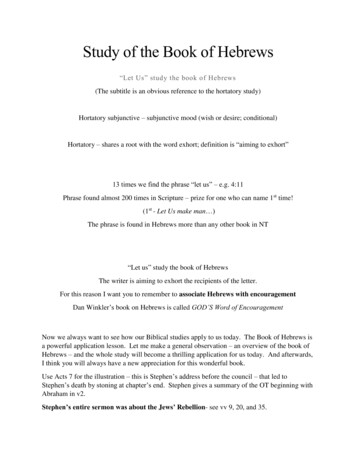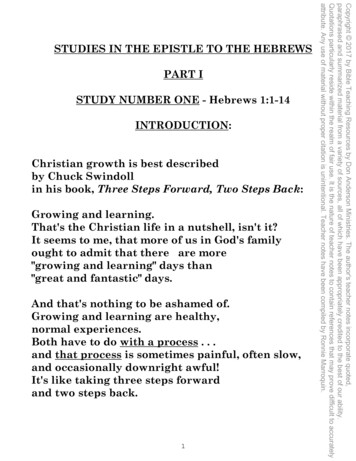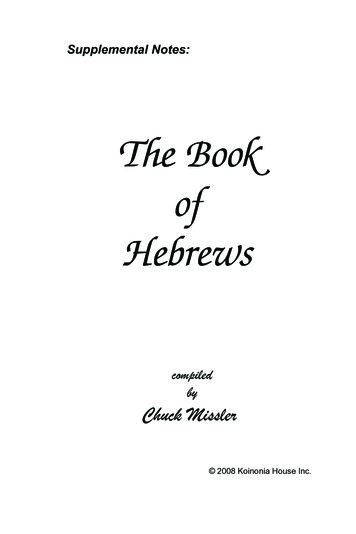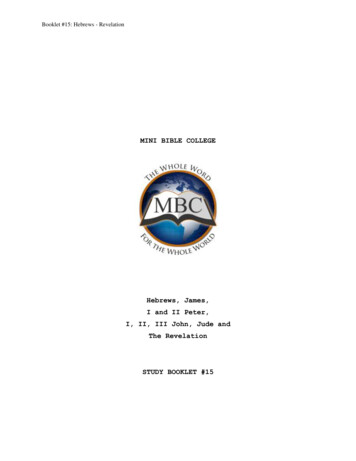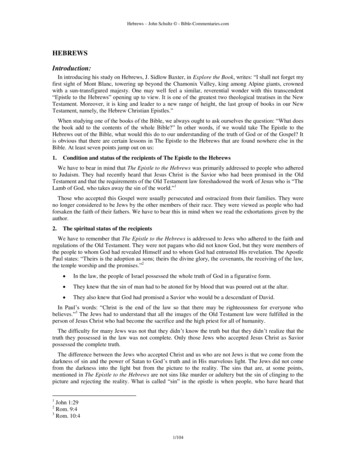
Transcription
Hebrews – John Schultz - Bible-Commentaries.comHEBREWSIntroduction:In introducing his study on Hebrews, J. Sidlow Baxter, in Explore the Book, writes: “I shall not forget myfirst sight of Mont Blanc, towering up beyond the Chamonix Valley, king among Alpine giants, crownedwith a sun-transfigured majesty. One may well feel a similar, reverential wonder with this transcendent“Epistle to the Hebrews” opening up to view. It is one of the greatest two theological treatises in the NewTestament. Moreover, it is king and leader to a new range of height, the last group of books in our NewTestament, namely, the Hebrew Christian Epistles.”When studying one of the books of the Bible, we always ought to ask ourselves the question: “What doesthe book add to the contents of the whole Bible?” In other words, if we would take The Epistle to theHebrews out of the Bible, what would this do to our understanding of the truth of God or of the Gospel? Itis obvious that there are certain lessons in The Epistle to the Hebrews that are found nowhere else in theBible. At least seven points jump out on us:1.Condition and status of the recipients of The Epistle to the HebrewsWe have to bear in mind that The Epistle to the Hebrews was primarily addressed to people who adheredto Judaism. They had recently heard that Jesus Christ is the Savior who had been promised in the OldTestament and that the requirements of the Old Testament law foreshadowed the work of Jesus who is “TheLamb of God, who takes away the sin of the world.” 1Those who accepted this Gospel were usually persecuted and ostracized from their families. They wereno longer considered to be Jews by the other members of their race. They were viewed as people who hadforsaken the faith of their fathers. We have to bear this in mind when we read the exhortations given by theauthor.2.The spiritual status of the recipientsWe have to remember that The Epistle to the Hebrews is addressed to Jews who adhered to the faith andregulations of the Old Testament. They were not pagans who did not know God, but they were members ofthe people to whom God had revealed Himself and to whom God had entrusted His revelation. The ApostlePaul states: “Theirs is the adoption as sons; theirs the divine glory, the covenants, the receiving of the law,the temple worship and the promises.”2 In the law, the people of Israel possessed the whole truth of God in a figurative form. They knew that the sin of man had to be atoned for by blood that was poured out at the altar. They also knew that God had promised a Savior who would be a descendant of David.In Paul’s words: “Christ is the end of the law so that there may be righteousness for everyone whobelieves.”3 The Jews had to understand that all the images of the Old Testament law were fulfilled in theperson of Jesus Christ who had become the sacrifice and the high priest for all of humanity.The difficulty for many Jews was not that they didn’t know the truth but that they didn’t realize that thetruth they possessed in the law was not complete. Only those Jews who accepted Jesus Christ as Saviorpossessed the complete truth.The difference between the Jews who accepted Christ and us who are not Jews is that we come from thedarkness of sin and the power of Satan to God’s truth and in His marvelous light. The Jews did not comefrom the darkness into the light but from the picture to the reality. The sins that are, at some points,mentioned in The Epistle to the Hebrews are not sins like murder or adultery but the sin of clinging to thepicture and rejecting the reality. What is called “sin” in the epistle is when people, who have heard that1John 1:29Rom. 9:43Rom. 10:421/104
Hebrews – John Schultz - Bible-Commentaries.comJesus poured out His blood for the atonement of the sin of men, reject this blood and continue putting theirtrust in animal blood for the covering of their sin, this.By way of illustration, let’s say that a man’s wife goes away for a weekend to a retreat, leaving thehusband alone at home. He has her picture that he puts on his nightstand and when he goes to bed at night,he speaks to the picture, tells it that he loves her and wishes her a good night of sleep. Two days later, thewife comes home and the husband meets her at the door, saying: “I don’t really want you to come inside. Iam perfectly happy with the picture I have of you.” The story pushes the truth to the point of ridicule, butthe Jews, who knew that they had the picture of their Messiah in the Old Testament ritual law, and rejectedJesus Christ as the Messiah, actually did the same thing. They preferred the picture to the reality itrepresented.3.The concept of man in The Epistle to the HebrewsThe Epistle to the Hebrews teaches that man occupies a high position in God’s plan. God placed man ona higher level in the order of creation than the angels. The fact that man sinned made him also fall from thiselevated position. This is the reason man usually considers himself to be inferior to angels. But redeemedman is rehabilitated and restored to his original rank. “Are not all angels ministering spirits sent to servethose who will inherit salvation?” (ch. 1:14). “It is not to angels that he has subjected the world to come,about which we are speaking. But there is a place where someone has testified: ‘What is man that you aremindful of him, the son of man that you care for him? You made him a little lower than the angels; youcrowned him with glory and honor and put everything under his feet.’ In putting everything under him, Godleft nothing that is not subject to him. Yet at present we do not see everything subject to him. But we seeJesus, who was made a little lower than the angels, now crowned with glory and honor because he suffereddeath, so that by the grace of God he might taste death for everyone” (ch. 2:5-9). No other creature isdestined to sit with God on His throne. “Our fathers disciplined us for a little while as they thought best; butGod disciplines us for our good, that we may share in his holiness” (ch. 12:10).4.The concept of Christ’s position in this present dispensationNo other book in the Bible explains what Jesus is doing in heaven at the present time. “The Son is the radiance of God’s glory and the exact representation of his being, sustaining allthings by his powerful word. After he had provided purification for sins, he sat down at the righthand of the Majesty in heaven” (ch. 1:3). “Therefore, since we have a great high priest who has gone through the heavens, Jesus the Son ofGod, let us hold firmly to the faith we profess” (ch. 4:14). “The point of what we are saying is this: We do have such a high priest, who sat down at the righthand of the throne of the Majesty in heaven, and who serves in the sanctuary, the true tabernacleset up by the Lord, not by man” (ch. 8:1-2).The Epistle to the Hebrews explains that Jesus serves as high priest in the real sanctuary. Aaron’spriesthood and the ceremonies in the tabernacle and in the temple in Jerusalem foreshadowed this heavenlyreality. It is for this reason that Jesus’ humanity is emphasized so strongly in The Epistle to the Hebrews.5.The concept of the salvation of manThe salvation that is mentioned in The Epistle to the Hebrews is complete salvation. “Therefore he is ableto save completely those who come to God through him, because he always lives to intercede for them”(ch. 7:25). The opening verses of The Epistle to the Hebrews indicate that the sin question has been dealtwith completely (See ch. 1:3). The important matter now is that people, whose sin has been atoned for, arebrought to glory. The glory mentioned is not the heavenly glory we enter when we leave this world but aglory we have to pursue (ch. 12:14) and which is called “entering God’s rest” (ch. 4:10).There is a close relationship between complete salvation and Jesus’ intercession for us in heaven (ch.7:25).6.The meaning of Old Testament worship is explained in relation to Jesus’ ministry at present.2/104
Hebrews – John Schultz - Bible-Commentaries.comNo other book in the Bible explains so clearly the meaning and purpose of the ceremonial law that isrecorded in Exodus, Leviticus, and Numbers than The Epistle to the Hebrews. The author does notdownplay or reject the ceremonial law but he shows that the law merely foreshadows the salvation God hasprepared for us.7.The importance of the admonitionsThere is a heavy stress upon admonition in the following five sections:1.Pay attention to the Word of the Son of God2:1-42.Make every effort to enter God’s rest3:7 – 4:133.Do not fall away5:11 – 6:204.On deliberate sin10:26 – 395.Do not sin and reject Christ12:14 – 29These admonitions are not parentheses, as some believe, but they are part of the real topic of The Epistleto the Hebrews. They are the main lessons for people who were used to follow the Old Testament form ofworship and who have come to understand that the shadows of the ceremonial law are fulfilled in thereality of Jesus Christ.3/104
Hebrews – John Schultz - Bible-Commentaries.comOutline:We borrow the outline of the book from Nelson’s Illustrated Bible Dictionary:HEBREWS . 1Introduction:. 1Part One: The Superiority of Christ’s Person (1:1—4:13) . 6I.The Superiority of Christ over the Prophets 1:1-3 . 6II. The Superiority of Christ over the Angels 1:4—2:18 . 9A. Christ Is Superior because of His Deity1:4-14 . 9B. First Warning: Danger of Neglect 2:1-4 . 12C. Christ Is Superior because of His Humanity 2:5-18 . 13III. The Superiority of Christ over Moses 3:1—4:13 . 21A. Christ Is Superior to Moses in His Work 3:1-4 . 21B. Christ Is Superior to Moses in His Person3:5-6 . 22C. Second Warning: Danger of Unbelief 3:7—4:13 . 24Part Two: The Superiority of Christ’s Work (4:14—10:18) . 31I. The Superiority of Christ’s Priesthood 4:14—7:28 . 31A. Christ Is Superior in His Position 4:14-16 . 31B. Christ Is Superior in His Qualifications5:1-10 . 33C. Third Warning: Danger of Not Maturing5:11-6:20 . 37D. Christ Is Superior in His Priestly Order 7:1-28 . 41II. The Superiority of Christ’s Covenant 8:1-13 . 45A. A Better Covenant 8:1-6. 45III. The Superiority of Christ’s Sanctuary and Sacrifice9:1—10:18 . 49A. Old Covenant’s Sanctuary and Sacrifice 9:1-10 . 49B. New Covenant’s Sanctuary and Sacrifice9:11-10:18 . 52Part Three: The Superiority of the Christian’s Walk of Faith (10:19—13:25). 60I. A Call to Full Assurance of Faith10:19—11:40 . 60A. Hold Fast the Confession of Faith10:19-25 . 60B. Fourth Warning: Danger of Drawing Back 10:26-39 . 64C. Definition of Faith 11:1-3 . 68D. Examples of Faith 11:4-40 . 691. Abel 11:4 . 694/104
Hebrews – John Schultz - Bible-Commentaries.com2. Enoch11:5-6 . 703. Noah11:7 . 724. Abraham and Sarah 11:8-19 . 735. Isaac11:20 . 776. Jacob11:21 . 787. Joseph 11:22 . 788. Moses’ Parents 11:23 . 799. Moses 11:24-29 . 8010. Joshua and Rahab 11:30-31 . 8311. Many Other Heroes of Faith 11:32-40 . 83II. Endurance of Faith 12:1-29 . 86A. Example of Christ’s Endurance 12:1-4 . 86B. A Call to Endure God’s Chastening 12:5-24 . 88C. Fifth Warning: Danger of Refusing God 12:25-29 . 93III. A Call to Love 13:1-17 . 95A. Love in the Social Realm13:1-6 . 95B. Love in the Religious Realm 13:7-17 . 97IV.Conclusion 13:18-25 . 1015/104
Hebrews – John Schultz - Bible-Commentaries.comPart One: The Superiority of Christ’s Person (1:1—4:13)I.The Superiority of Christ over the Prophets 1:1-31 In the past God spoke to our forefathers through the prophets at many times and in various ways,2 but in these last days he has spoken to us by his Son, whom he appointed heir of all things, andthrough whom he made the universe.3 The Son is the radiance of God’s glory and the exact representation of his being, sustaining all thingsby his powerful word. After he had provided purification for sins, he sat down at the right hand of theMajesty in heaven.The epistle opens with some of the most beautiful and powerful words in the whole New Testament. Allof human history is divided in two parts: God’s speaking to Israel through the prophets in the OldTestament and God’s speaking to us in Jesus Christ in the New Testament.Andrew Murray, in his book The Holiest of All, says about “God has spoken” that it means:1- An introduction to glory2- A vehicle of fellowship3- Imperfectly and provisionally through the prophets - Perfectly through the Son4- A revelation of God’s heart5- Vehicles of this life, saving power, love6- Speaking claims hearingDonald Gunthrie, in his commentary on Hebrews, states that the past has bearing on the present. Heproceeds: “This principle is basic to the New Testament and is nowhere brought to focus so clearly as inHebrews. What strikes the writer is the variety of ways in which God had spoken in the past. He does notlist them, but uses the expression In many and various ways. Anyone acquainted with the Old Testamentwould at once be able to fill in the details – the different modes (visions, angelic revelations, propheticwords and events) and the different occasions (stretching across the whole vista of Old Testament history).The most illuminating revelations came through the prophets. These were men raised up by God tochallenge their own time. Their badge of office was the unshakeable conviction that they spoke from God.Their ability to say, ‘God says,’ gave their words a unique authority. They were ill-treated (as Heb. 11:33ff.shows) and yet they persisted with their message. Their stories make heroic reading, but what they said wasincomplete. The writer knows that it needed a better method of communication, and he recognizes that thishas come in Jesus Christ. If this is so we might wonder why the old cannot be forgotten. After all, whatJesus reveals is better than the prophets. Nevertheless the continuity is kept. What was said in the past(palai) prepared the way for the most important communication of all (i.e. revelation through the Son). Thisis the real theme of the whole letter: the past has given way to better things. This is the reason why the past(Old Testament religious ideas) keeps coming into the picture in this epistle, only to fade out again as betterideas fulfill and expand it. It is easy to see why the writer begins as he does. He sees value in the past (forGod spoke through it), but he also sees its imperfections. What he says cannot fail to throw light on theChristian approach to the Old Testament. This makes his letter valuable for today as well as for his owntime.”The fact that God speaks by His Son is nowhere so powerfully brought forth as in the prologue of John’sGospel, where Jesus is called logos, “the Word.”The Adam Clarke’s Commentary states: “We can scarcely conceive anything more dignified than theopening of this letter; the sentiments are exceedingly elevated, and the language, harmony itself. Theinfinite God is at once produced to view, not in any of those attributes which are essential to the divinenature, but in the manifestations of his love to the world, by giving a revelation of his will relative to thesalvation of mankind, and thus preparing the way, through a long train of years, for the introduction of thatmost glorious Being, his own Son. This Son, in the fullness of time, was manifested in the flesh that hemight complete all vision and prophecy, supply all that was wanting to perfect the great scheme of6/104
Hebrews – John Schultz - Bible-Commentaries.comrevelation for the instruction of the world, and then die to put away sin by the sacrifice of himself. Thedescription which he gives of this glorious personage is elevated beyond all comparison. Even in hishumiliation, his suffering of death excepted, he is infinitely exalted above all the angelic host, is the objectof their unceasing adoration, is permanent on his eternal throne at the right hand of the Father, and fromhim they all receive their commands to minister to those whom he has redeemed by his blood. In short, thisfirst chapter, which may be considered the introduction to the whole letter is, for importance of subject,dignity of expression, harmony and energy of language, compression and yet distinctness of ideas, equal, ifnot superior, to any other part of the New Testament.”The Pulpit Commentary observes about the phrase, rendered “many times and in various ways,” that “theGreek structure of the whole with its rhythmical flow, betokens an original composition. The rolling musicof the language cannot, of course, be reproduced in an English translation.”The term “our forefathers” is the translation of the single Greek word patrásin, “fathers,” referring to allprevious generation of the Jewish people. The “various ways” in which God spoke includes what God saidthrough the greatest Old Testament prophet, Moses, who not only received the Ten Commandments, butalso the whole ceremonial law with all its provisions of atonement for the sins of the people. It is good toremember this, as Paul says that “Christ is the end of the law so that there may be righteousness foreveryone who believes.”4In painting his picture of “the Son,” the author spans all of eternity by reaching out to the end of time andback to its beginning. Christ being “appointed heir of all things,” refers to the consummation of creationand “through whom he made the universe” to the beginning. It was through the Son that the Father calledeverything into being. In the Genesis record of creation, we read: “In the beginning God created theheavens and the earth,” and “God said, ‘Let there be light.’” The creation of the universe as well as thecalling into of light and all that follows was the result of God’s speaking through His Son. The ApostlePaul says about Jesus Christ: “For by him all things were created: things in heaven and on earth, visible andinvisible, whether thrones or powers or rulers or authorities; all things were created by him and for him. Heis before all things, and in him all things hold together.” 5Andrew Murray, in his book The Holiest of All, writes about God’s speaking: “God has spoken!Speaking is the vehicle of fellowship. It is a proof that the speaker considers the one he addresses ascapable of fellowship with himself, a token that he longs for that fellowship. Man was created forfellowship with God; sin interrupted it. Nature speaks of God and His work; but of Himself, His heart, andHis thoughts of love toward us as sinners, nature cannot tell. In his deepest misery, man seeks for God–buthow often, to all appearance, in vain. But, God be praised, this seeking in vain is not for always. Thesilence has been broken. God calls man back to fellowship with Himself. God has spoken!”God’s speaking through His Son involves infinitely more than speaking to us only; it refers to everythingvisible and invisible. In the same way as God’s speaking resulted in creation, His Word takes form in aPerson, the Second Person of the Godhead. This does not mean that the Father’s Word created the Son, but,as far as we are concerned it revealed Him. The Word of God is eternal; it existed before the creation oftime.The eye of our created body is unable to see God. But when the Word became flesh, the invisible Godbecame visible to us. So Jesus could say to His disciples: “Anyone who has seen me has seen the Father.” 6We could say, however, that the Father is just as much hidden in the Son as He is revealed in Him. Theradiance of God’s glory was not visible in Jesus’ human body, except at one time during thetransfiguration. Mark writes about this moment: “His clothes became dazzling white, whiter than anyone inthe world could bleach them.”7 And Peter, who witnessed this, writes: “We were eyewitnesses of hismajesty. For he received honor and glory from God the Father when the voice came to him from the4Rom. 10:4Col. 1:16,176John 14:97Mark 9:357/104
Hebrews – John Schultz - Bible-Commentaries.comMajestic Glory, saying, ‘This is my Son, whom I love; with him I am well pleased.’ We ourselves heardthis voice that came from heaven when we were with him on the sacred mountain.” 8The glory about which the author speaks here surpasses anything visible on earth. Jesus is called “theradiance of God’s glory.” The Greek word used is apaugasma. Vine’s Expository Dictionary of BiblicalWords defines this: “The ‘glory’ of God expresses all that He is in His nature and His actings and theirmanifestation. The Son, being one with the Father in Godhood, is in Himself, and ever was, the shiningforth of the ‘glory,’ manifesting in Himself all that God is and does, all, for instance, that is involved in Hisbeing ‘the very image of His substance,’ and in His creative acts, His sustaining power, and in His makingpurification of sins, with all that pertains thereto and issues from it.”The Wycliffe Bible Commentary comments: “The shining forth to the world of the very character of Godin Jesus Christ. He is the essential being of God. In the same way express image is used, as in Matt 22:20,where it refers to the image on the Roman coin. Christ is the stamp or impress of God (charakter); theessence of God. The whole force of the first two clauses of this verse stresses this one concept.”Whereas His radiance refers to His relationship with the Father, His relationship to creation is expressedin the fact that He is the power that holds all together. The Word not only created, it also sustainseverything. The Greek verb phero has a rather wide meaning, ranging from “to bring” to “to carry.” Paul’sdefinition is probably clearest, when he writes: “in him all things hold together.” 9 Christ’s Word is thepower that holds all the atoms of created matter.The whole story of His suffering, crucifixion and death is dealt with in the few words “he had providedpurification for sins.” The emphasis is on the finality, not on the process. The Greek word, rendered here“purification,” is katharismos, which literally means “washing off.” It is used for the ceremonial cleansingof people and objects in the Old Testament rites. Jesus used the word when He said to the leper He hadhealed: “See that you don’t tell this to anyone. But go, show yourself to the priest and offer the sacrificesthat Moses commanded for your cleansing, as a testimony to them.”10 Andrew Murray, in his book TheHoliest of All, writes about this: “The cleansing of sins, as something effected by Christ before He went toheaven, is the foundation of all His work. Let us learn, at the very start, that what God has to speak to us inChrist begins here: Sin must be cleansed away. This is the root-thought of redemption. As long as we seeksalvation chiefly from the desire of personal safety, or as long as we approach the study of Christ’s personand work as the revelation of what is true and beautiful and good, we cannot enter fully into its power. It isthe cleaning of sin God insists on–and with a desire so intense that He gave His Son to die for it. It is in theintense desire for the cleansing of sins that, all the way through the Christian life, our spiritual capacity toapproach and enter into the salvation of Christ will be found. This desire of God’s heart lies at the root ofall. It is the secret of Christian perfection. It was only when Christ had effected this cleansing that heavenopened to Him. The full acceptance of the cleansing of sins–as the meaning of the word cleansing will beunfolded later on – will be to us, too, the entrance into heavenly life.”What strikes us most in the way this is stated is the finality. For us, who have experienced salvation, thesin problem is not finished yet. We do not usually feel our cleansing is a done deal, as if there is nothingleft that should be taken care off. The fact that our sinful nature has not totally died, even if we considerourselves as crucified with Christ, makes it difficult for us to accept that God considers us His finishedproducts. Yet, it is on the basis of the closure of our case that God can extend daily forgiveness to us as anact of righteousness. As the Apostle John writes: “If we confess our sins, he is faithful and just and willforgive us our sins and purify us from all unrighteousness.” 11At this point the humanity of Jesus Christ has not yet been referred to. It is, however, understood in theprocess of purification of human sin. It was in Christ’s human body that the sin problem was taken care of.Consequently, it is the Man Jesus Christ, as well as the Second Person of the Trinity, who is presentlyseated at the right hand of the Majesty in heaven. Andrew Murray, in The Holiest of All, writes: “When Hehad effected the cleansing of sins, he ‘sat down on the right hand of the Majesty on high.’ There He lives,opening up and keeping open the blessed access to God’s presence and fellowship for us while lifting us up8II Peter 1:16-18Col. 1:1710Mark 1:4411I John 1:998/104
Hebrews – John Schultz - Bible-Commentaries.cominto and maintaining us in its enjoyment. And in the power that prevails there, He makes the kingdom ofheaven a reality within the heart. It is the great object of the epistle to bring home to us the heavenly gloryof Christ as the ground of our confidence, the measure of our expectation, and the character of that inwardsalvation He imparts. That Christ, as our Leader and Forerunner, has rent asunder the veil and, in the powerof His blood, has taken possession of and secured access into the Holiest of All does not mean that we areto enter heaven only when we die. The whole practical teaching of the epistle is summed up and applied inthe one word: ‘We have boldness for entering in. Let us draw near. Let us enter in.’ (See Hebrews 10:1922). The fact of Christ being seated on the throne in heaven means we can actually be brought–through thesupernatural power that the Holy Spirit supplies–into God’s holy presence, living there our daily life. It wasbecause the Hebrews did not know this–because they had rested content with elementary truths about faithand conversion and the life in heaven after death–that they had so notably failed. Truly, to know Jesus atthe right hand of God would be the healing of diseases and their restoration to the joy and strength of a lifecarried out in accordance with their heavenly calling.”Donald Guthrie, in Hebrews, writes: “The act of sitting (he sat down, ekathisen, aorist) carries a strongsense of fulfillment, for a sitting position is more suggestive of a finished task than a standing position.Indeed, this emphasis on Christ seated, which is supported by other New Testament evidence, showsconclusively that the sacrificial work is done. There is no longer any need for such sacrifice. The sittingposition may also denote a position of high honor. There is only one reference of Christ standing in heaven:when Stephen saw the Son of man in heaven he saw him standing at the right hand of God (Acts 7:56).This refers to his work of intercession, not his work of sacrifice. Sin has been dealt with, but th
No other book in the Bible explains what Jesus is doing in heaven at the present time. “The Son is the radiance of God’s glory and the exact representation of his being, sustaining all things by his powerful word. After he had provided purification for sins, he sat down at the right h
